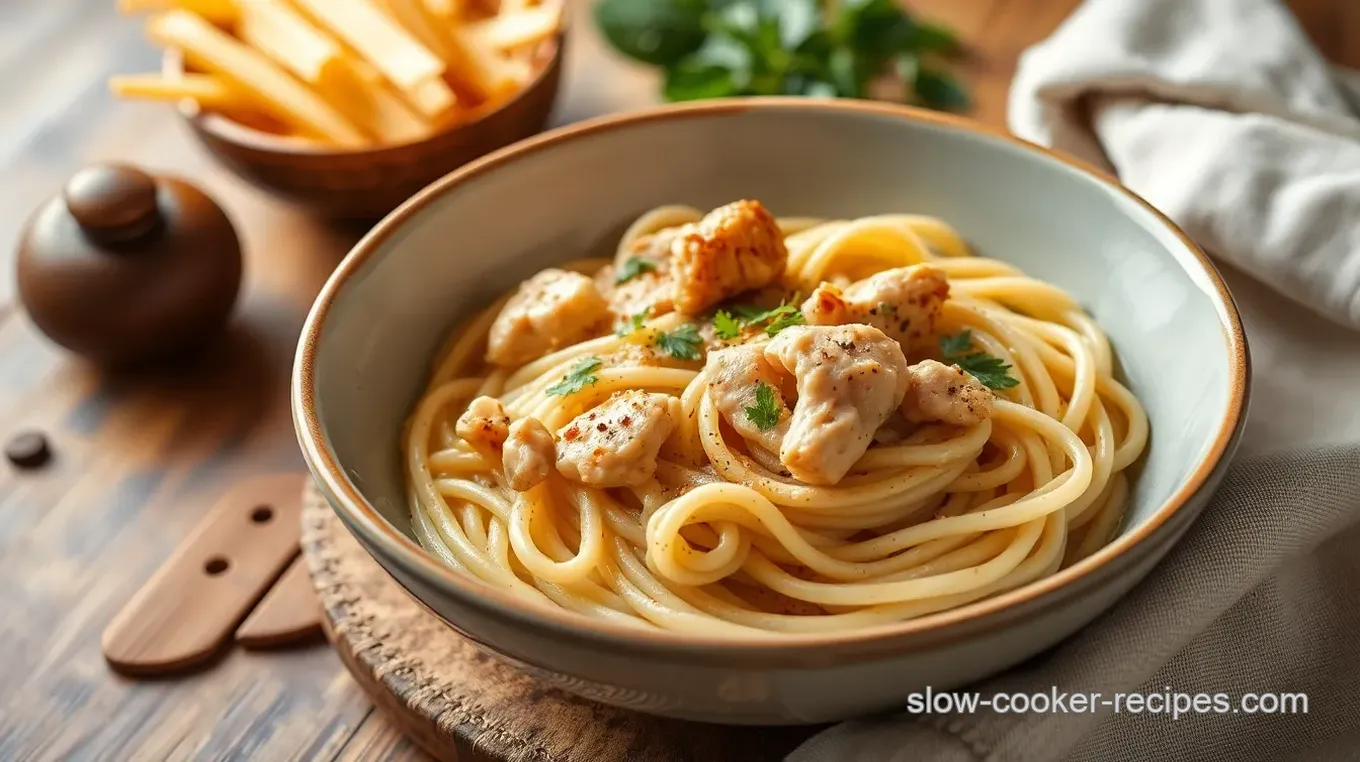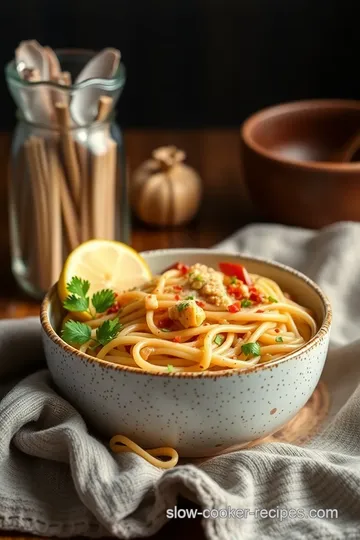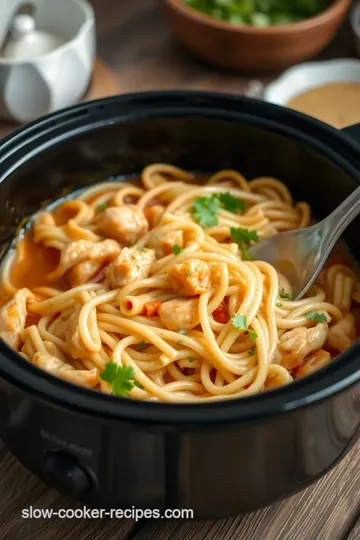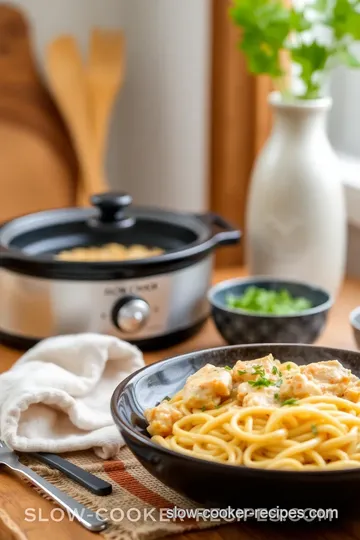Homemade Chicken Noodle Soup: A Cozy Comfort Food Classic
Craving the best Cook Homemade Chicken Noodle Comfort Food? My simple, cozy version warms hearts and bellies, perfect for busy weeknights! Get the recipe inside!

Oh my gosh, i still remember the first time i made homemade chicken noodle soup . i was feeling under the weather, and you know how it is—the soul craves something warm and cozy.
I tossed a few things into a pot, and before i knew it, my kitchen smelled like a hug. i thought, "is this the best homemade chicken noodle soup ever?" it’s pretty amazing how a simple dish can turn a gloomy day into something bright and hopeful.
Listen, no one can resist a piping hot bowl of comfort food recipes . whether you’re sick, stressed, or just craving something hearty, chicken noodle soup has your back.
It’s like a warm blanket for your insides , you know? this recipe hits all the spots—flavor, comfort, and a sprinkle of nostalgia!
Recipe Overview
Now, let’s talk history. chicken noodle soup dates back generations, but every family has its own spin on it. from classic recipes passed down through generations to modern takes in trendy cafes, this dish has evolved yet stayed comforting.
Today, it's a staple in countless households. did you know that in the u.s., it’s practically a rite of passage for every young cook? yup, this easy chicken soup is often where beginners flex their culinary muscles.
You can whip this up in about 45 minutes . with just 15 minutes of prep and 30 minutes of cooking, that’s less time than most of us spend scrolling through social media.
And trust me—this easy meal idea for busy weeks is worth every minute! it serves about six hearty portions, perfect for a family dinner or meal prep.
Cost-wise, it’s super friendly. You can gather all the ingredients for under $20 , especially if you grab rotisserie chicken. Talk about saving time and money!
Key Benefits
Eating homemade soup is not just a treat; it’s a health boost too! picture this: nutritional chicken recipes filled with wholesome ingredients that warm you up inside.
Chicken broth is great for hydration, and those yummy vegetables? they're packed with vitamins. not to mention, if you're ever feeling under the weather, this soup is like a cozy hug for your immune system.
This chicken noodle soup recipe is perfect for special occasions—think winter holidays or even a comforting meal after a long week.
It’s not just for colds and flu; it’s for any moment you want to feel good.
What's unique here is how adaptable it is. want to try different chicken noodle variations? go for it! you can even add spices like ginger for a ginger garlic soup twist.
How about customizing your veggies? go wild with peas, spinach, or whatever floats your boat.
And let’s not forget how kid-friendly this dish is. even the pickiest eaters usually dig into a bowl of hearty chicken broth soup .
Plus, it’s a one-pot meal , which means less clean-up. win-win!
When it comes to convenience, this soup also stores beautifully. make-ahead chicken noodle soup? yes, please! you can pop it in the fridge and reheat it for easy lunches or dinners all week.
Just remember to get those soup garnishes ready—nothing like a sprinkle of fresh parsley to liven it up!
So, are you ready to dive into the world of cozy kitchens and warm memories? let’s check out the ingredients you’ll need to cook this magical soup.
I promise you won’t regret it!

Essential Ingredients Guide for Homemade Chicken Noodle Soup
Ah, there's nothing like a cozy bowl of homemade chicken noodle comfort food to warm you up on a chilly day.
This classic dish is simple to whip up and absolutely satisfying. let’s dive into some essential ingredients and tips that’ll have you cooking a delicious soup your family will love.
Seriously, they’ll be begging for seconds!
Premium Core Components
When you're gathering those ingredients, knowing the right measurements is key. For our chicken noodle soup, you'll need:
- 1 tablespoon (15 ml) of olive oil - this is your base.
- 1 medium onion, diced (about 1 cup or 150 g) - the flavor powerhouse.
- 2 medium carrots, sliced (about 1 cup or 120 g) - for that sweet balance.
- 2 celery stalks, diced (about 1 cup or 100 g) - adds that crunch.
- 8 cups (1.9 liters) of low-sodium chicken broth - the heart of your soup!
- 2 cups (approximately 280 g) of shredded cooked chicken - rotisserie chicken is perfect for ease.
- 2 cups (200 g) of egg noodles - they soak up all those delicious flavors.
- A sprinkle of spices: 1 teaspoon (5 g) each of dried thyme and dried parsley gives it that comforting aroma.
Quality Indicators and Freshness Tips
Now, when you're selecting your ingredients, you want fresh veggies! look for onions that are firm and dry. carrots should be vibrant and crisp.
If you're buying chicken, go for those gloriously golden rotisserie options . if you’re making your own broth, homemade is always better; just be sure to strain out any gristle.
Storage is simple. keep fresh veggies in the fridge, broth can last up to a week when stored properly, and any leftover soup can be stored for about 3-4 days .
Getting greasy? store it in a tightly sealed container.
Signature Seasoning Blend
The magic happens with the spices and herbs! you can’t go wrong with the classic dried thyme and parsley combo, but don’t be shy! feel free to mix in other herbs according to your taste! basil or rosemary can elevate your soup to new heights.
Need a kick? sprinkle in some red pepper flakes. depending on your roots, toss in some cajun seasoning for a southern flair or even a bit of curry powder for something different.
Smart Substitutions
Everyone’s got their twists on this classic, right? if someone in your fam is gluten-free, whole wheat or gluten-free noodles can be a game-changer.
Running low on chicken? sub in turkey for a savory soup recipe that’s just as good (or better!). you can use beans instead of chicken for a vegetarian option.
And if you ever forget an ingredient—no sweat! no egg noodles? just chop up and throw in some rice or quinoa.
Have a random bag of frozen veggies? toss those in! adaptability is your best friend when it comes to cozy winter meals.
Kitchen Equipment Essentials
Now, let’s talk gear. You don’t need a five-star kitchen setup to make this soup shine. Here's what you need:
- A large soup pot or Dutch oven is a must. Trust me, you won’t regret going big.
- A sharp knife and cutting board for your chopping game.
- Measuring cups and spoons to keep those ratios in check.
- A ladle for serving—couldn’t get more basic than that.
If you don’t have a Dutch oven, a regular pot works just fine. And hey, if you have a pressure cooker, an instant pot chicken noodle soup is super quick and delicious.
Wrap It Up
Cooking is all about enjoying the process, building memories, and sharing them with those you love. so, as you prepare to cook homemade chicken noodle comfort food , remember that this is where heartwarming meals come to life.
The kitchen should feel like a warm hug, filled with aromas that make you feel all cozy inside—like snuggling under a soft blanket after a long day.
Now that you have the essentials down, let’s get into making that best homemade chicken noodle soup your family will crave. Ready? Let’s heat things up!

Home Cooking Like a Pro: Your Guide to Making the Best Homemade Chicken Noodle Soup
Hey there, fellow foodies! you know that feeling when you just want to curl up on the couch with a bowl of something warm and cozy? nothing hits the spot quite like homemade chicken noodle soup .
This dish is the ultimate comfort food for cold days, and trust me—it’s easier to make than you think! let’s dive into the professional cooking methods you'll need to whip up this classic soup.
Essential Preparation Steps
First things first, let's talk about mise en place . this french term simply means "everything in its place." chop your onions, carrots, and celery ahead of time.
It's a game changer! you’ll be able to cook faster and with way less stress. seriously, i once thought i could chop as i go, and oh boy, did that lead to chaos!
Next, let’s chat time management . once you start cooking, the timer becomes your best friend. for our chicken noodle soup, you’ll have about 30 minutes of cooking time , but with prep, you're looking at around 45 minutes total .
So keep an eye on the clock; it’ll help keep the noodles from turning mushy.
And don't forget about safety! Always wash your hands after handling raw chicken. Cooking should be fun, not hazardous.
Step-by-Step Process
Alright, here’s where things get exciting! Let’s break down the cooking like this:
- Heat the Oil : In a large soup pot, add 1 tablespoon of olive oil and heat it on medium.
- Sauté Your Veggies : Toss in 1 cup of diced onion , 1 cup of sliced carrots , and 1 cup of diced celery . Let those sauté for 5- 7 minutes until they soften. Stir in 2 cloves of minced garlic , cooking for an additional minute until it smells heavenly.
- Add Your Broth : Pour in 8 cups of low-sodium chicken broth . Bring that to a boil.
- Toss in the Chicken and Herbs : Add 2 cups of shredded cooked chicken (using rotisserie chicken? Genius!). Sprinkle 1 teaspoon each of dried thyme and dried parsley . Season with salt and pepper to taste.
- Bring on the Noodles : Once it’s boiling, stir in 2 cups of egg noodles . Cook them according to package instructions, usually around 6- 8 minutes . I always peek at them to catch that perfection ; we want tender but not mushy!
- Final Touches : After tasting, adjust any seasonings before ladling it into bowls. Garnish with fresh parsley for a pop of color!
Expert Techniques
Cooking up the best homemade chicken noodle soup is all about finesse. Keep these techniques in mind:
- Quality Checkpoints : Make sure each ingredient is fresh and quality. Trust me, it makes a world of difference.
- Adjust for Taste : If the soup feels lacking, a dash of lemon juice or a splash of soy sauce can elevate those flavors.
- Troubleshooting : If it seems too salty, add a cup of water or some more veggies to balance it out.
Success Strategies
Now, let’s avoid the common mistakes that can pop up. overcooking the noodles? a no-no! remember, they continue to cook in the hot broth after you take it off the heat.
Always aim for that delightful al dente texture.
For those of you curious about meal prep, this homemade chicken noodle soup can be made in advance and stored in the fridge for up to a week .
How great is that for easy meal ideas?
Closing Thoughts
So, you've got your cozy bowl of homemade soup that’s not just a classic recipe, but also a warm hug in a bowl.
Whether you’re cooking for family or just for yourself, this soup hits all the right notes — it’s hearty, delicious, and full of love.
Up next, we’ll dive into some additional information about variations, substitutions, and tips to customize your chicken noodle deliciousness to your heart's desire! So stick around; your journey into cozy winter meals is just beginning!

Discover Secrets to Your Homemade Chicken Noodle Comfort Food
Oh my gosh, who doesn’t love a warm bowl of homemade chicken noodle soup ? it’s like a hug in a bowl, especially on chilly days or when you’re just feeling a bit under the weather.
But there’s more to this beloved comfort food recipe than just boiling some chicken and tossing in a few noodles.
Let’s dive into some pro tips, serving suggestions, and even storage info that’ll up your soup game.
Pro Tips & Secrets to Amazing Soup
Chef secrets? you bet! the beauty of a chicken noodle soup recipe lies in the details. first off, always use rotisserie chicken ; it saves you time and adds so much flavor—like it was made in grandma's kitchen! when sautéing your vegetables , let them get nice and soft before adding in the broth.
Don't rush this step! it makes a world of difference.
Also, here’s a time-saver: prep your veggies ahead of time. chop them up and store 'em in the fridge. that way, when it’s soup night, you can whip things together in a flash.
And for a flavor enhancement, throw in a splash of lemon juice right before you serve! it brightens everything up and makes your savory soup recipes really pop.
Perfect Presentation: Make It Wow!
We eat with our eyes first, right? so let’s make that soup look as good as it tastes. use a shallow, wide bowl to plate your soup; it just makes everything look fancier.
You can sprinkle fresh parsley on top for that pop of color. and don’t forget about pairing it with a crusty bread roll! a little soup garnish on the side can take it from comfort to gourmet in seconds.
When it comes to color combinations in your soup, don’t be afraid to mix it up! add some vibrant veggies like bright green peas or red bell peppers to create textures and hues that are just enticing.
Not only does it look gorgeous, but it turns a simple meal prep idea into a visual feast.
Storage & Make-Ahead Bliss
One of the best parts about this homemade soup recipe is how easy it is to store. after your hearty soup cools down, transfer it to airtight containers.
You can even freeze portions for those chaotic weeknights. just like that, you have an instant meal ready at your fingertips!
When you’re ready to eat, just thaw it out overnight in the fridge, then heat it gently on the stove or in the microwave.
And here’s a tip: add a splash of broth when reheating to restore that lovely silkiness to your noodles. freshness duration in the fridge is about 3-4 days, but frozen soup can last up to three months!
Get Creative with Variations
The best part? there are endless ways to make this comfort food your own! want to jazz it up for fall? toss in some roasted butternut squash.
Feeling spicy? a hint of chili powder will kick things up!
Got any dietary restrictions? swap regular noodles for gluten-free options . you can even use vegetable broth instead of chicken broth for a nice vegetarian twist.
Be brave with your flavors—this soup is your canvas!
Complete Nutrition Guide for Your Heartwarming Meal
Don’t just think about the warmth; think about the goodness, too! This nutritional chicken recipe packs in protein from the chicken and nutrients from all the veggies.
With a serving of about 300 calories, it's light enough to not weigh you down yet fulfilling enough to keep you satisfied.
Not to mention, studies show that healthy chicken soup is great for your immune system. win-win, right?
Wrap It Up with Love
At the end of the day, cooking homemade chicken noodle comfort food is all about making memories and warming hearts.
Whether you’re sharing it with family or curled up on the couch with a good book, it’s the kind of dish that brings joy.
So, gather your ingredients, turn on your favorite tunes, and get started on this classic. it’s an easy meal idea for busy weeks , and trust me, once you dive into that fragrant, soul-soothing bowl of goodness, you’ll be hooked.
Happy cooking, friends!
Frequently Asked Questions
What is the best way to cook homemade chicken noodle comfort food?
The best way to cook homemade chicken noodle comfort food is to start by sautéing vegetables in olive oil for flavor, then adding broth and cooked chicken. Incorporate egg noodles last to ensure they cook perfectly without becoming mushy. Following this method provides a rich, hearty soup in just under an hour!
Can I use frozen chicken for this chicken noodle soup recipe?
Yes, you can use frozen chicken, but it will require additional cooking time. Just ensure the chicken is fully cooked before shredding it into the soup. Alternatively, consider using rotisserie chicken to save time and enhance flavor.
How should I store leftover homemade chicken noodle soup?
To store leftover soup, allow it to cool completely, then transfer it to an airtight container. It can be refrigerated for up to 3-4 days or frozen for up to 3 months. When reheating, you may need to add a little extra broth for moisture as the noodles absorb liquid over time.
Can I make this chicken noodle soup ahead of time?
Absolutely! You can make homemade chicken noodle comfort food ahead of time and reheat it when you're ready to serve. It's a fantastic option for meal prep. Just be sure to undercook the noodles slightly if you're planning to store it, as they'll continue to soften when reheated.
What are some nutritious variations to add to chicken noodle soup?
To boost nutrition, consider adding vegetables like spinach, kale, or peas. Additionally, you could include grains such as quinoa or brown rice instead of noodles for a heartier option. Swapping out egg noodles for whole grain or gluten-free pasta is also a great way to cater to dietary preferences.
How can I enhance the flavor of my homemade chicken noodle soup?
Enhance the flavor by using homemade chicken broth instead of store-bought for richer taste. Adding fresh herbs like thyme or rosemary right at the end can also uplift the dish. A splash of lemon juice or a dash of your favorite hot sauce can provide an unexpected burst of freshness and complexity.
Homemade Chicken Noodle Soup: A Cozy Comfort Food Classic Card

⚖️ Ingredients:
- 1 tablespoon olive oil
- 1 medium onion, diced
- 2 medium carrots, sliced
- 2 celery stalks, diced
- 2 cloves garlic, minced
- 8 cups low-sodium chicken broth
- 2 cups shredded cooked chicken
- 2 cups egg noodles
- 1 teaspoon dried thyme
- 1 teaspoon dried parsley
- Salt and black pepper to taste
- Optional: Fresh parsley for garnish
🥄 Instructions:
- Step 1: Heat olive oil in a large pot over medium heat. Add diced onion, carrots, and celery. Sauté until softened, about 5-7 minutes.
- Step 2: Stir in minced garlic and cook for an additional minute until fragrant.
- Step 3: Pour in the chicken broth and bring to a boil. Stir in shredded chicken, thyme, and parsley. Season with salt and pepper.
- Step 4: Once boiling, add egg noodles to the pot. Cook according to package instructions, typically 6-8 minutes.
- Step 5: Taste the soup and adjust seasoning if necessary. Serve hot, garnished with fresh parsley if desired.
Previous Recipe: Decadent No-Bake Nanaimo Bars with Luscious Creamy Custard: A Family Favorite
Next Recipe: Best Roast Potatoes with Crunchy Golden Exterior: My Family’s Favorite Recipe
